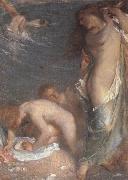Wholesale Oil Painting No Minimum |
|||||||||||
|
|
|||||||||||

|
|||||||||||
|
|
|
||||||||
Charles Hazelwood ShannonEnglish painter, printmaker and collector , 1863-1937 English artist, was born at Sleaford in Lincolnshire, the son of the Rev. Frederic Shannon. He attended the City and Guilds of London Art School (then known as South London School of Technical Art, formerly Lambeth School of Art), and was subsequently considerably influenced by his lifetime partner Charles Ricketts[2] and by the example of the great Venetians. In his early work he was addicted to a heavy low tone, which he abandoned subsequently for dearer and more transparent colour. He achieved great success with his portraits and his Giorgionesque figure compositions, which are marked by a classic sense of style, and with his etchings and lithographic designs. The Dublin Municipal Gallery owns his circular composition "The Bunch of Grapes" and "The Lady with the Green Fan" (portrait of Mrs Hacon). His "Study in Grey" is at the Munich Gallery, a "Portrait of Mr Staats Forbes" at Bremen, and a "Souvenir of Van Dyck" at Melbourne. One of his most remarkable pictures is "The Toilet of Venus" in the collection of Lord Northcliffe. Several of his portrait works are on display in the National Portrait Gallery in London. Complete sets of his lithographs and etchings have been acquired by the British Museum and the Berlin and Dresden print rooms. He was awarded a first-class gold medal at Munich in 1895 and a first-class silver medal in Paris in 1900. |
||||||||
|
|
||||||||
Pearl Fishers
Pearl Fishers Painting ID:: 28000 |
1896
Oil on canvas 93.9 x 68.5 cm
(37 x 27in)
Fine Art Society,London (mk63) 1896 Oil on canvas 93.9 x 68.5 cm (37 x 27in) Fine Art Society,London (mk63) |
|||||||
|
|
||||||||
|
ALLORI Alessandro Italian Mannerist Painter, 1535-1607 Born in Florence. After the death of his father in 1540 he was brought up and trained in art by a close friend, often referred to as his 'uncle', the mannerist painter Agnolo Bronzino, whose name he sometimes assumed in his pictures. In some ways, Allori is the last of the line of prominent Florentine painters, of generally undiluted Tuscan artistic heritage: Andrea del Sarto worked with Fra Bartolomeo (as well as Leonardo Da Vinci), Pontormo briefly worked under Andrea, and trained Bronzino, who trained Allori. Subsequent generations in the city would be strongly influenced by the tide of Baroque styles pre-eminent in other parts of Italy. Freedburg derides Allori as derivative, claiming he illustrates "the ideal of Maniera by which art (and style) are generated out of pre-existing art." The polish of figures has an unnatural marble-like form as if he aimed for cold statuary. It can be said of late phase mannerist painting in Florence, that the city that had early breathed life into statuary with the works of masters like Donatello and Michelangelo, was still so awed by them that it petrified the poses of figures in painting. While by 1600 the Baroque elsewhere was beginning to give life to painted figures, Florence was painting two-dimensional statues. Furthermore, in general, with the exception of the Contra Maniera artists, it dared not stray from high themes or stray into high emotion. Pearl Fishers Oil on slate, 116 x 86 cm cyf |
||||||||
|
|
||||||||
|
Prev Next
|
||||||||
|
|
||||||||
|
Related Paintings to ALLORI Alessandro :. |
||||||||
|
|
||||||||
|
CONTACT US |

